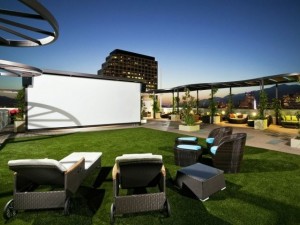Share This
Related Posts
Tags
Amenity Arms Race
By Leah Etling on Nov 21, 2013 in News
Los Angeles—Gen Y likes rooftop pools, multimedia-equipped fitness suites, concierge package service and the ability to order housekeeping for their apartment. They have dogs, get lots of UPS deliveries but almost no mail, like walking places (but also need to charge their electric vehicles), and want the lobby of their apartment community it look like that of a four-star hotel.

The rooftop skydeck, a coveted Gen Y amenity, is a selling feature of Eleve Glendale, a AMF Development community.
Sound high maintenance? It’s a fair assessment.
Last week, a panel of multifamily experts delivered an overview of “What Renters Want: Development + Design Trends that Drive Occupancy,” at an AIA continuing education event held in Los Angeles and sponsored by Multi-Housing News, Interface and Universal Fibers.
Speakers Manny Gonzalez, principal, KTGY Group; Kelly Farrell, vice president, RTKL; and Alan Dibartolomeo, chief development officer, AMF Development Inc. didn’t pull any punches when it came to the wish list of the nation’s largest renter demographic: 20-to-mid-30-somethings.
“Gen Y rents by choice. We’ll see if they continue to rent by choice as they age. But if they keep renting, your rentals will have to be flexible enough in their amenities program to meet their needs in the future and the needs of their kids,” said Farrell, who described the demand for services among today’s typical resident.
They want to be able to order up housekeeping, but not pay for it on a regular schedule, calling for an appointment when they have been too busy to clean or Mom and Dad are coming to visit. Someone should be in the lobby to receive their dry cleaning delivery and accept their packages while they work. Rent should be payable by credit card so they can auto-schedule the payment and forget about it.
The good news is that they’re willing to pay for these conveniences.
“It’s a generation that if they have the money, they want to be served,” said Dibartolomeo, whose firm competed a Glendale project, Eleve Glendale, near Americana at Brand and the Glendale Galleria that features a 26,000 square foot rooftop skydeck, replete with a dog park and hot tub.
The only disadvantage of creating such posh living spaces is that residents really do seem to think they’re at a resort.
“They really believe they’re in a hotel. And there’s a downside to that: they think they can barbecue and cook and just walk away and leave it, and somebody will clean it up. Almost everything is ‘somebody else will take care of it,’” Dibartolomeo said.
Describing some of the private student housing communities that have been developed across Southern California, Gonzalez implied that multifamily would likely have to raise the luxury bar to keep up with rising expectations. Does your community’s swimming pool feature a lazy river? How about a fitness center that rivals the offerings of the neighborhood’s most high-end health club?
“If your community isn’t big enough to do something like this, then don’t even try to do it. Get them a membership to the adjacent club. If you can’t go all the way, don’t just go halfway,” Gonzalez advised. He added, “It’s what I call the amenities arms race. Everything’s getting bigger, how much can we do? All the money seems to be going into the amenities: ‘My pool’s bigger than your pool.’”
This article originally appeared in Multi-Housing News online. Read the full story here.
